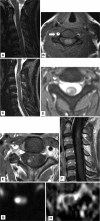Acute spinal-cord ischemia: evolution of MRI findings
- PMID: 23091532
- PMCID: PMC3469803
- DOI: 10.3988/jcn.2012.8.3.218
Acute spinal-cord ischemia: evolution of MRI findings
Abstract
Background and purpose: Magnetic resonance (MR) findings in acute spinal-cord ischemia can be summarized as focal cord enlargement and hyperintensities on T2-weighted images and gadolinium enhancement, especially of the central gray matter. However, in analogy with acute brain ischemia, it is to be expected that the findings of MR imaging (MRI) may be normal in the first hours after symptom onset. We evaluated the clinical and MRI findings in a series of patients with acute spinal-cord ischemia, and tested the hypothesis that the development and course of MR abnormalities are predictable.
Methods: Five patients with acute spinal-cord ischemia were admitted to our hospital over a 2-year period. Repeated MRI (1.5 T) was performed in all patients. Clinical data were retrieved from the patients' charts.
Results: Four women and one man with a median age of 52 years (range, 31-75 years) were admitted. Three patients had anterior spinal artery infarction and two patients had transverse infarctions. All patients underwent spinal MRI within 24 hours; the findings were normal in four of the five patients. After 1-2 days, T2-weighted MRI generally exhibited focal cord enlargement and hyperintensity in all patients, while spinal-cord enhancement appeared after 2-11 days.
Conclusions: Acute spinal-cord ischemia may have a typical course on MRI. MRI findings are usually normal in the acute phase, but spinal cord swelling and T2 abnormality are expected after several days, while gadolinium enhancement appears even later after symptom onset. The sensitivity and specificity of MRI can be increased by repeated MRI in patients suspected of acute spinal-cord ischemia.
Keywords: MRI; course; spinal-cord ischemia.
Conflict of interest statement
The authors have no financial conflicts of interest.
Figures

References
-
- de Seze J, Stojkovic T, Breteau G, Lucas C, Michon-Pasturel U, Gauvrit JY, et al. Acute myelopathies: Clinical, laboratory and outcome profiles in 79 cases. Brain. 2001;124:1509–1521. - PubMed
-
- Novy J, Carruzzo A, Maeder P, Bogousslavsky J. Spinal cord ischemia: clinical and imaging patterns, pathogenesis, and outcomes in 27 patients. Arch Neurol. 2006;63:1113–1120. - PubMed
-
- Nedeltchev K, Loher TJ, Stepper F, Arnold M, Schroth G, Mattle HP, et al. Long-term outcome of acute spinal cord ischemia syndrome. Stroke. 2004;35:560–565. - PubMed
-
- Weidauer S, Nichtweiss M, Lanfermann H, Zanella FE. Spinal cord infarction: MR imaging and clinical features in 16 cases. Neuroradiology. 2002;44:851–857. - PubMed
LinkOut - more resources
Full Text Sources

